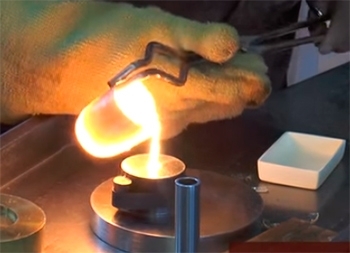

Scientists linked to a FAPESP-funded research center author six of the 25 most downloaded papers from the website of Journal of Non-Crystalline Solids, a prestigious publication on amorphous and glassy materials (photo: CeRTEV)
Scientists linked to a FAPESP-funded research center author six of the 25 most downloaded papers from the website of Journal of Non-Crystalline Solids, a prestigious publication on amorphous and glassy materials.
Scientists linked to a FAPESP-funded research center author six of the 25 most downloaded papers from the website of Journal of Non-Crystalline Solids, a prestigious publication on amorphous and glassy materials.

Scientists linked to a FAPESP-funded research center author six of the 25 most downloaded papers from the website of Journal of Non-Crystalline Solids, a prestigious publication on amorphous and glassy materials (photo: CeRTEV)
By Karina Toledo | Agência FAPESP – Many of us learned at school that there are three states of matter: solids, liquids and gases. More recently, a fourth state has been included: plasma, similar to the gaseous state but with some atoms ionized (positively charged).
None of the classical definitions appears adequate to describe glass.
In 2017, researcher Edgar Dutra Zanotto, a professor in the Department of Materials Engineering at the Federal University of São Carlos (DEMa-UFSCar), São Paulo State, Brazil, proposed the existence of a “glassy state of matter”, a hybrid state with the properties of both a solid and a liquid.
According to Zanotto, glass is not a solid but a non-crystalline state of matter outside thermodynamic equilibrium, in which thermal, chemical and mechanical equilibrium occur simultaneously. It appears solid on a short time scale but continuously relaxes toward the liquid state (read more at: agencia.fapesp.br/26370).
Written in collaboration with US scientist John C. Mauro, currently a professor at Penn State University in the United States, the paper was published in June 2017 (online version) in the Journal of Non-Crystalline Solids (JNCS) – the most longstanding journal on amorphous and glassy materials, founded in 1968 and published by Elsevier.
The paper currently heads the list of the 25 articles most downloaded from JNCS. Elsevier updates the list every three months. The latest is dated March 8, 2018. Since its inception, JNCS has published more than 25,000 articles and papers, or roughly a third of those submitted. Zanotto’s paper competes with all of them.
“The paper deals with a highly controversial subject and has attracted attention from several local and international scientific publications. Glass is an extremely complex material and is still poorly understood,” said Zanotto, who heads DEMa-UFSCar’s Center for Research, Teaching, and Innovation in Glass (CeRTEV), one of the Research, Innovation and Dissemination Centers (RIDCs) funded by FAPESP.
According to Zanotto, the concept of a “glassy state” is a major paradigm shift because glass has always been considered a non-crystalline or amorphous solid.
“It’s a vexed question, and I don’t know if there will ever be agreement on the issue. But we’re working hard to reach a consensus, and the paper has aroused interest in the scientific community,” he said.
On the Mendeley platform, another database maintained by Elsevier, the paper published in JNCS has had over 6,000 views, a significant number in Zanotto’s opinion, considering that there are some 3,000-5,000 active researchers in the field worldwide. It is estimated that in Brazil, between 100 and 120 scientists are engaged in research on glass.
The paper is also featured on the JNCS website as a Highlighted Article selected by Elsevier.
Visibility metric
The recent list of most downloaded articles posted by Elsevier brought more good news for the CeRTEV team. In second place is “Review: the structure of simple phosphate glasses” by Richard K. Brow, a professor at Missouri University of Science & Technology in the United States and a member of CeRTEV’s advisory board.
Work by two former students affiliated with CeRTEV also figures in the list. In sixth place is the article “Electrical conductivity of silicate glasses with tetravalent cations substituting Si”, one of whose authors is Ervino C. Ziemath, former grantee of a postdoctoral scholarship from FAPESP at DEMa-UFSCar and currently a professor at São Paulo State University (UNESP) in Rio Claro.
In tenth place is “Strain-rate sensitivity of glasses”, one of whose authors is Bruno P. Rodrigues, former master’s student at DEMa-UFSCar and currently a postdoctoral scholar in Australia.
In eleventh place is another article of which Zanotto is co-author: “Crystal growth and viscous flow in barium disilicate glass”. Next, in twelfth place, is the review “Bioactive glasses: Special applications outside the skeletal system”, among whose authors is Aldo R. Boccaccini, a researcher at the University of Erlangen-Nuremberg in Germany and also a member of CeRTEV’s advisory board.
“It was a pleasant surprise to hear that the twelve most downloaded articles include four from our RIDC and two others by important collaborators,” Zanotto said. “This isn’t a direct measure of research quality but should undeniably be seen as a visibility metric. The studies conducted by CeRTEV are at the knowledge frontier and arouse interest in the international community.”
The fact that two former students are on the list, he added, shows that the RIDC has also done good work in human resource training.
Watch this video for a better understanding of the “glassy state of matter”: youtube.com/watch?v=eYIWiFeKt5o.
More information: vidro.ufscar.br and certev.ufscar.br/slideshow/slideshow.
Republish
The Agency FAPESP licenses news via Creative Commons (CC-BY-NC-ND) so that they can be republished free of charge and in a simple way by other digital or printed vehicles. Agência FAPESP must be credited as the source of the content being republished and the name of the reporter (if any) must be attributed. Using the HMTL button below allows compliance with these rules, detailed in Digital Republishing Policy FAPESP.





